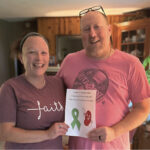 Elysa Springer of Harrisburg says she turns into Eeyore every winter.
Elysa Springer of Harrisburg says she turns into Eeyore every winter.
Winnie-the-Pooh’s friend—a gloomy gray donkey—epitomizes how she feels, as the amount of daylight grows shorter and shorter. The winter solstice on Dec. 21 marks the shortest amount of daylight, or longest night of the year.
“It starts around the middle of October—I notice I have a lot less motivation,” said Springer. “When it’s not light out till 7 a.m., it’s all downhill for me. It’s depressing to go to work when it’s dark and to leave work when it’s dark.”
Seeing the Light
Light seems to be a key factor—for Springer and many others.
But one silver lining of the pandemic, for Springer, is that she’s worked from home since March 2020. In her home office, “things are better,” because she has “an actual window.”
Pre-pandemic, as director of systems and data management for the commonwealth’s Office of Children, Youth and Families, Springer worked in a state office building “with glass blocks in the windows” where sunlight didn’t stream in.
“I don’t see how it doesn’t affect everyone,” Springer said. “I think everybody’s affected [by the change in season].”
Whether it’s less sunlight or freezing cold temperatures, a lot of people just plain hate winter, amirite?
“I’m one of those people,” said Dr. Melissa Brown, a licensed psychologist who practices in Harrisburg with UPMC in Central Pa. She was half-laughing, but half-serious, too.
“People blame winter, but it really brings a set of symptoms,” Brown said, that generally bring people down.
When is it SAD?
While many people feel—like Springer—a drop in energy, motivation and mood during the winter, it can actually be a much more serious condition for others. Seasonal Affective Disorder (SAD) is a type of depression, diagnosed by either a primary care physician or a psychologist like Brown.
SAD symptoms include feelings of depression, lethargy, malaise, oversleeping or restless sleep, lack of concentration, decreased interest in activities, substantial weight gain or weight loss, and a craving for unhealthy foods.
“People [with SAD] feel like they want to go into hibernation mode because SAD is a type of depression triggered by a reduction in the brain chemical serotonin,” Brown said.
And why does serotonin drop? It’s regulated by our exposure to light. So, just like bears heading into hibernation, when our serotonin drops, our brains tell us to hunker down.
There are three medical treatments for people diagnosed with SAD, Brown said. Therapy with a psychologist can help people develop strategies to cope, antidepressants can stabilize symptoms and mood, and then there’s something called light therapy.
Light Bulb Moment
Light therapy is used not only for people formally diagnosed with SAD, but it’s also gone somewhat mainstream. Just do a quick search on Amazon, and you’ll find a wide variety of light boxes available, many with “happy light” or “happy mood” in the description.
So how does it work?
“It’s artificial light with a specific output of lumens that helps recalibrate our brain chemicals, which we know impacts our mood,” Brown said. “It helps calibrate our circadian rhythms, synching with our light and wake cycles. If you think about hibernation, the lack of sunlight sends a message to your brain that you should be sleeping and not moving and grooving.”
Although she’s never been diagnosed with SAD, Springer has seen the light, so to speak. She researched the options several years ago and finally settled on a $50 light (some are much more, others are even less). It sits on her desk, and she switches it on daily, from October through April.
“I didn’t notice a difference instantaneously, but I was definitely a little less down in the dumps,” Springer said. “I wouldn’t say it’s a magic light, but it definitely helps.”
Hers looks similar to a halo light—a pandemic panic purchase by many people trying to improve their Zoom appearances. So, if nothing else, Springer notes with a laugh that it also improves her look on Zoom.
Brown agrees that light boxes could be helpful for people like Springer “who just need a little help” getting through winter. Generally, people use light therapy for about 20 to 30 minutes once or twice a day.
“I think most people can attest to that great feeling of warmth that the sun provides for us,” Brown said. “Just the comfort those light boxes could bring people who especially are teetering, as a preventative measure, is something I would recommend.”
Mood Menders
As a blueprint for avoiding the winter blues, among people not formally diagnosed with SAD, Brown recommends healthy self-care, including a good diet of vitamin-rich foods, regular exercise, staying connected socially, and getting outside daily despite cold winter temperatures.
“Sometimes, we see connections between a reduction in Vitamin D levels partly because we naturally absorb Vitamin D from the sun, and that reduction impacts our mood as well,” Brown said. “I tell people to go outside every day for 15 minutes—it kind of charges us up.”
She notes that SAD cases increase the further you move away from the equator. So hey, look on the bright side. Compared to Alaskans, we Pennsylvanians might not have it so bad. And there’s a light at the end of the tunnel. By the end of the month, on Dec. 31, there are only 79 days till the first day of spring.
Dr. Melissa Brown practices at UPMC in Central PA’s PinnacleHealth Psychological Associates, 205 S. Front St., Harrisburg, 717-231-8360.
If you like what we do, please support our work. Become a Friend of TheBurg!





